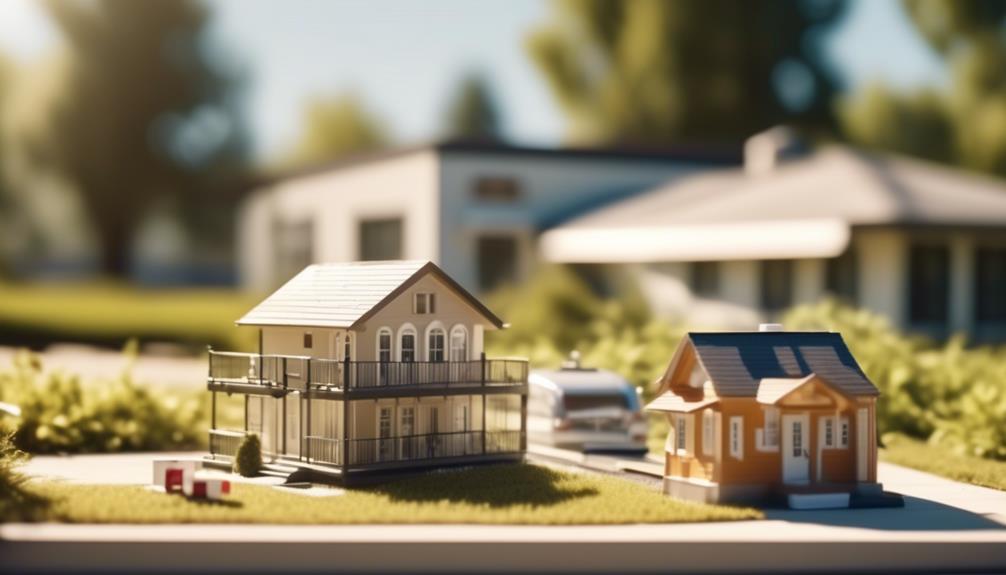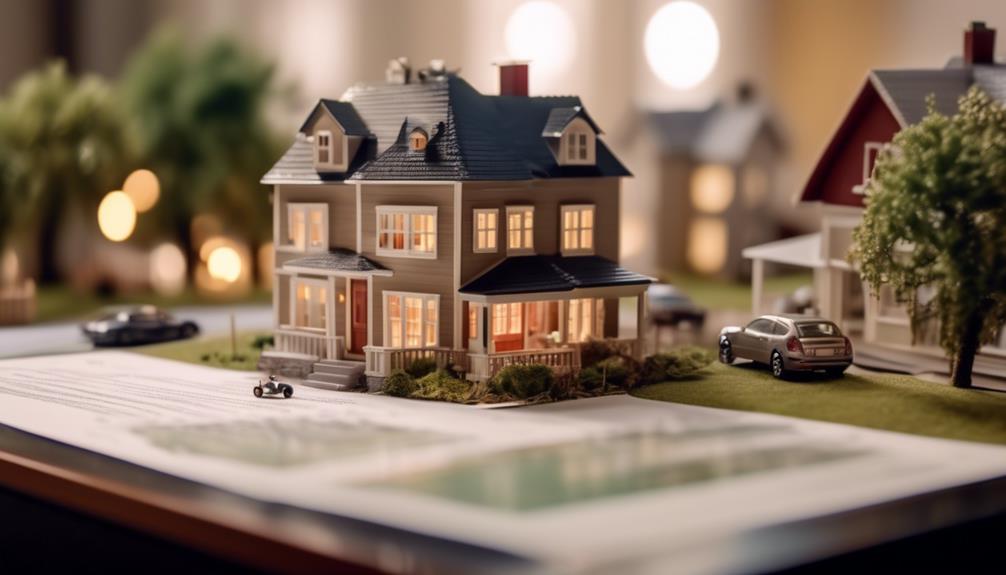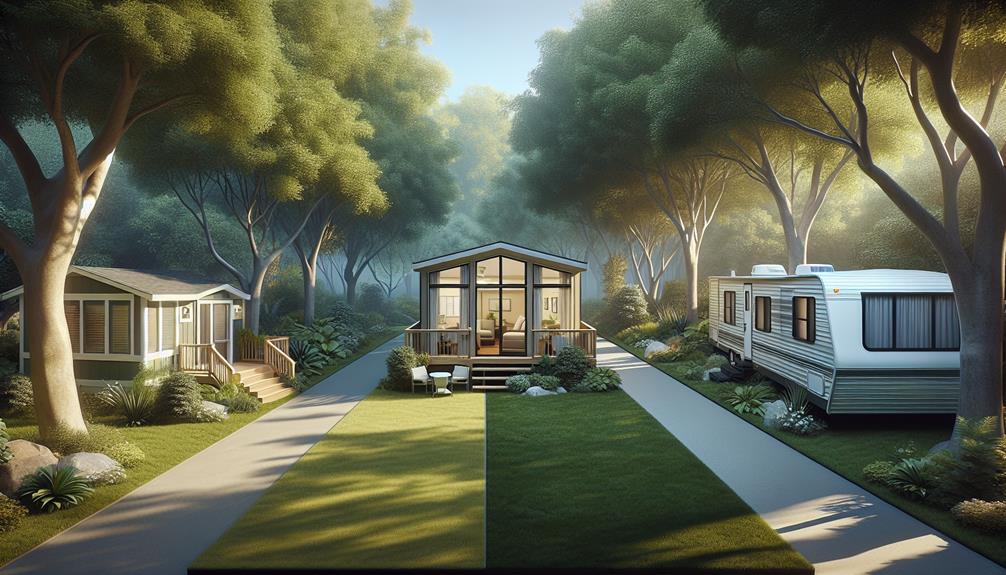Like a chameleon blends into its environment, a park model home often resembles a mobile home in appearance and function, yet you might be surprised by the differences that set them apart. You've likely seen these quaint structures nestled in vacation spots or retirement communities, and you may have even considered them as a charming alternative to traditional housing.
However, as you weigh your options, you must understand the distinct regulations and standards that define a park model. Unlike mobile homes, park models are crafted to comply with RV industry codes, and with their size capped at a cozy 400 square feet, they straddle the line between a recreational vehicle and a permanent residence.
As you consider the allure of a simpler, downsized lifestyle, keep in mind that the classification of your chosen abode will impact not only your living experience but also legalities such as zoning, taxes, and insurance. So, ask yourself, do the unique characteristics of a park model home align with your vision of a dream dwelling, or do you find yourself gravitating towards the traditional mobile home and its own set of perks and challenges?
Key Takeaways
- Park model homes are categorized as recreational vehicles and adhere to specialized RV industry codes and standards.
- Park models are designed for leisure and sometimes permanent residences, with a size restriction of 400 square feet.
- Park models offer home-style amenities and modern design, but are designed for RV parks and seasonal stays, unlike mobile homes which offer a more permanent form of residence.
- Park models follow ANSI A119.5 regulations, while mobile homes follow the HUD Code.
Defining Park Model Homes
Park model homes, distinct from mobile homes, are categorized as recreational vehicles that adhere to specialized RV industry codes and standards. Unlike manufactured homes governed by federal building codes, park model RVs embrace a unique set of guidelines designed for vehicles meant for leisure and sometimes permanent residences.
These units are strategically engineered for placement in mobile home parks, where they often become long-term fixtures. With a size restriction of 400 square feet, they challenge the notion of traditional RVs by offering home-style amenities and modern design.
Park model homes represent a hybrid in the housing spectrum, blurring the lines between the transient nature of recreational vehicles and the stability of manufactured homes, yet remain firmly within the RV industry's purview.
Park Models Vs. Mobile Homes
While defining park model homes highlights their unique position within RV standards, comparing them to mobile homes reveals distinct differences in size, regulations, and intended use. You're looking at two housing solutions that cater to different lifestyles and necessities. Park models are akin to a blend of mobile luxury and stationary charm, designed for RV parks and seasonal stays. On the other hand, mobile homes, adhering to the HUD code, offer a more permanent form of residence, aligning with the standards for manufactured housing.
| Feature | Park Models | Mobile Homes |
|---|---|---|
| Size Limit | Up to 400 sq. ft. | Exceeds 400 sq. ft. |
| Building Standards | ANSI A119.5 (RV standards) | HUD Code (Construction and safety) |
| Customization | Highly customizable | Customizable, typically larger |
| Intended Use | Recreational, RV parks | Permanent residence, private land/parks |
| Regulations | RV-oriented | Manufactured housing standards |
These distinctions reflect the innovative thinking shaping today's housing options.
Regulatory Standards and Codes

Navigating the regulatory landscape, you'll find that mobile homes and park models are governed by distinct sets of standards, with the former adhering to HUD codes and the latter to ANSI A119.5 regulations.
Mobile homes, often called manufactured homes, are constructed under the stringent HUD rules, ensuring they meet the national building standards for safety and durability. These homes are regulated by HUD, an agency within the U.S. Department of Housing and Urban Development, tasked with overseeing various housing policies and programs.
In contrast, a park model, while also built in a factory, escapes the reach of HUD's regulatory framework. Instead, it complies with the ANSI A119.5 standard, focusing on recreational use and offering more flexibility in design and customization.
This distinct separation highlights the innovative potential and targeted functionality of park models in the housing market.
Advantages of Park Model Living
You'll discover that one of the key benefits of park model living is the ability to customize your space to suit your unique tastes and needs. Unlike the typical mobile home, park models offer a tailored housing experience, with interior layouts and exterior designs that reflect your personal style.
These buildings maximize every square foot, providing a comfortable and efficient living area. Additionally, the affordability of park models positions them as an innovative and cost-effective alternative within the housing market.
They're not only perfect for recreational or seasonal use but also offer flexibility in placement, fitting seamlessly into trailer parks and Recreation Vehicle (RV) spaces.
Moreover, despite their modest size, park models can yield a significant return on investment, enhancing their appeal as a smart housing choice.
Challenges With Park Model Homes

Despite the appealing customization and efficiency of park model homes, they come with their own set of challenges, such as restrictive zoning and limited financing options that can impact their practicality as a housing solution.
The zoning limitations often mean you can't place park models just anywhere, which restricts your housing choices. You might also struggle to secure financing, as lenders are less familiar with these homes compared to traditional mobile homes, affecting their affordability.
Moreover, park model homes are designed for recreational use, not necessarily as long-term residences, which can be problematic if you're looking for a permanent home. Their size is capped at 400 square feet, limiting living space and customization potential.
Additionally, the legal classification as RVs or manufactured homes adds complexity, creating regulatory confusion for owners and authorities.
Frequently Asked Questions
What Is the Difference Between a Mobile Home and Park Model?
You'll find park models and mobile homes differ in construction, size limits, zoning laws, design, mobility, ownership costs, seasonal use, and utility connections, offering distinct living experiences tailored to diverse needs and preferences.
Are Park Homes Mobile?
Park homes, poised between portable living and permanent placement, aren't mobile. They adhere to size limitations within community environments, offering ownership benefits akin to vacation dwellings under specific zoning regulations, yet lack home mobility.
What Is the Definition of a Park Model Home?
A park model home offers you a blend of tiny living and custom design, optimized for space efficiency and adhering to zoning regulations, ideal as a seasonal residence or cost-effective vacation property.
Are Trailer Park Homes Mobile?
You're navigating a sea of choices where travel flexibility, zoning regulations, and lifestyle choice intersect. Trailer park homes, while mobile, balance design variety and community living, often with seasonal occupancy and variable resale value.
Conclusion
In essence, your park model is the Tortoise's shell, offering a snug refuge that's not quite the nomadic Hare's mobile home. Anchored in design yet liberated from HUD's grasp, it balances permanence with the freedom of the RV world.
Embrace its compact charm and utility, but navigate its unique hurdles with care. As with any abode, it's your castle, albeit on a smaller, yet no less grand, scale.

